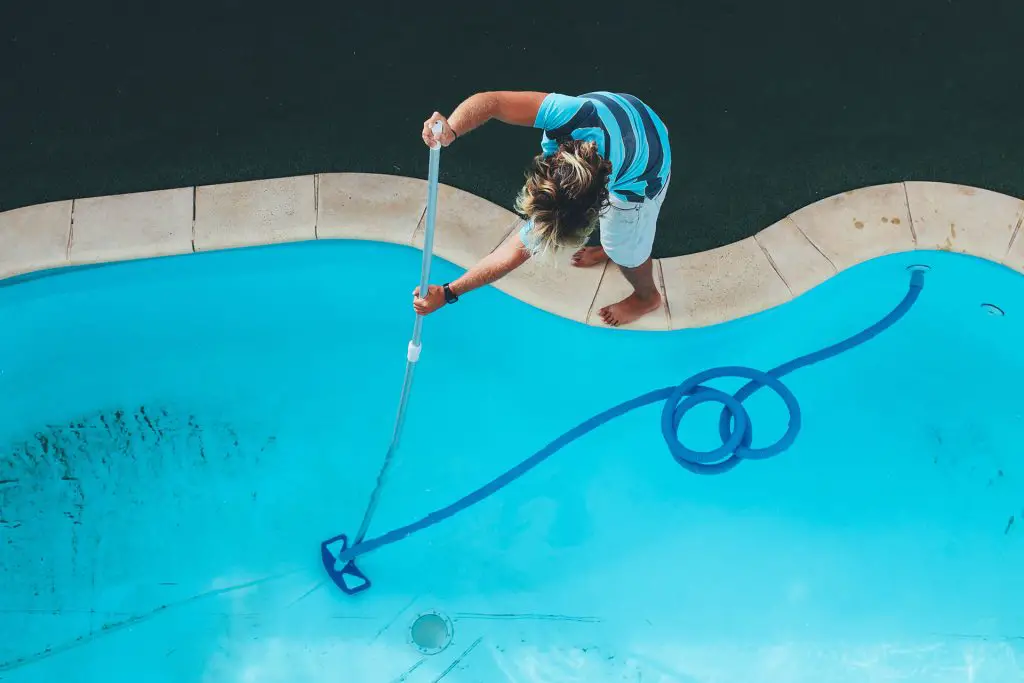To clean a pool, start by skimming the surface for debris and leaves. Then, brush the walls and floor before vacuuming the pool to remove any dirt or algae.
Choosing The Right Cleaning Equipment
When it comes to maintaining a crystal-clear pool, selecting the right cleaning equipment is paramount. Proper equipment not only ensures a sparkling pool but also makes the cleaning process more efficient, saving time and effort.
Selecting The Appropriate Pool Skimmer
To keep your pool free of leaves, bugs, and other debris, choosing the right pool skimmer is crucial. Look for a skimmer with a durable mesh net and a sturdy, easy-to-grip handle. Ensure the width of the skimmer is appropriate for your pool size to effectively remove debris from the water’s surface.
Invest in a telescopic pole to attach the skimmer, allowing for easy maneuvering and reaching all areas of the pool. Keep in mind the depth of your pool when selecting the pole length to ensure it can effectively reach debris at the pool’s deepest points.
Investing In A Quality Pool Vacuum
When it comes to thoroughly cleaning the pool floor and walls, a quality pool vacuum is essential. Look for a versatile and durable vacuum that can effectively remove dirt, leaves, and algae from all pool surfaces. Consider a vacuum with adjustable suction power to accommodate different levels of debris and ensure efficient cleaning.
Invest in a model with a wide cleaning path and rotating brushes to ensure thorough and efficient cleaning. Additionally, choosing a robotic pool vacuum can offer convenience and efficiency, as these units operate independently and can clean the pool without supervision.

Credit: m.youtube.com
Developing A Cleaning Schedule
Developing a cleaning schedule for your pool is essential to keep the water clear, the tiles sparkling, and the equipment functioning efficiently. By following a consistent cleaning routine, you can maintain your pool’s cleanliness, extend its lifespan, and ensure a safe and enjoyable swimming environment for your family and friends.
Determining Frequency Based On Usage
To determine how often you need to clean your pool, consider factors such as the pool’s size, the number of swimmers, and the surrounding environment. Pools used frequently or located near trees may require more frequent cleaning to remove debris and maintain water quality. Assess your pool’s specific needs to establish a cleaning frequency that suits your usage patterns.
Creating A Weekly Maintenance Plan
Setting up a weekly maintenance plan can help you stay on top of essential cleaning tasks. Identify specific days for tasks such as skimming the pool surface, vacuuming the pool floor, and checking and cleaning the filter. By creating a consistent schedule, you can prevent debris buildup and ensure that your pool is always ready for a refreshing swim. A well-maintained pool is not only visually appealing but also a safer and more enjoyable space for recreational activities.
Skimming And Surface Cleaning
Removing Debris With A Skimmer
To keep your pool clean, use a skimmer to remove leaves and debris daily.
- Start by skimming the surface in a slow and steady motion.
- Focus on areas around the pool’s edges and near any obstructions.
- Empty the skimmer basket regularly to maintain efficient cleaning.
Cleaning Surface Stains
To tackle surface stains effectively, use suitable pool cleaning products.
- Identify the type of stain before choosing the appropriate cleaning solution.
- Apply the cleaner to the affected area and scrub gently with a brush.
- Rinse the area thoroughly to remove any residue and prevent discoloration.

Credit: www.youtube.com
Vacuuming And Scrubbing
Keeping your pool clean is an essential part of pool maintenance. Vacuuming and scrubbing are two key tasks that help to remove dirt, debris, and algae buildup, ensuring your pool water remains sparkling clean. In this section, we will explore effective techniques for using a pool vacuum efficiently and scrubbing the walls and steps of your pool to maintain a hygienic swimming environment.
Using A Pool Vacuum Efficiently
A pool vacuum is a valuable tool in maintaining the cleanliness of your pool. Here are some tips to help you use a pool vacuum effectively:
- Start by skimming the surface of your pool to remove any large debris such as leaves or twigs that can clog the vacuum.
- Ensure that the vacuum hose is securely attached to the vacuum head and the skimmer or vacuum port.
- Prime the vacuum by filling the hose with water, submerging it completely to expel any trapped air.
- Move the vacuum head slowly and systematically across the pool, overlapping each pass to ensure thorough cleaning.
- Pay special attention to corners, stairs, and other hard-to-reach areas where debris tends to accumulate.
- Empty the skimmer or collection bag frequently to maintain optimal suction power.
- Regularly inspect the vacuum components for any signs of wear or damage and replace or repair as necessary.
Scrubbing Walls And Steps
To maintain a clean and inviting pool, it’s important to regularly scrub the pool walls and steps. Here’s how you can effectively scrub these areas:
- Fill a pool brush with water, ensuring the bristles are wet before scrubbing.
- Start at the waterline and work your way down, using long, sweeping motions.
- Pay attention to areas with visible dirt, algae, or stains. Apply extra pressure if necessary.
- For the pool steps, scrub both the surface and the undersides to remove any buildup.
- If your pool has a vinyl liner, use a soft brush to prevent any damage to the liner.
- After scrubbing, use a pool net or vacuum to remove any loosened debris from the water.
- Repeat this process regularly to prevent the buildup of algae and other contaminants.
Balancing Chemical Levels
To maintain a clean and safe pool, proper chemical balance is essential.
Testing And Adjusting Ph Levels
Regularly test and adjust pH levels to prevent algae growth and protect swimmers’ skin.
Maintaining Proper Chlorine Levels
Chlorine kills bacteria and viruses in the pool, so make sure levels are always adequate.
Monitoring Filtration System
One essential aspect of pool maintenance is regularly monitoring the filtration system. The filtration system is responsible for keeping your pool water clean and clear from debris and contaminants. Proper monitoring ensures that your filtration system is functioning effectively, allowing you to enjoy a pristine pool throughout the swim season.
Regularly Checking Filters
Filters play a crucial role in trapping and removing various impurities from the pool water. As they continuously filter out debris, leaves, and dirt, they can become clogged over time.
To ensure optimal performance, it is important to regularly check the filters. Ideally, this should be done at least once a week. By inspecting the filters, you can identify any signs of damage or clogging, allowing you to take prompt action.
You can visually inspect the filters for any visible debris or signs of wear and tear. Additionally, it is recommended to check the pressure gauge on your filtration system. If the pressure readings are abnormally high, it could indicate that the filters are dirty and need to be cleaned or replaced.
Backwashing And Cleaning Filters
Backwashing is a technique used to clean pool filters and remove accumulated debris. This process involves reversing the flow of water through the filter, dislodging and flushing away any trapped impurities.
To backwash your filters, follow these simple steps:
- Turn off the pool pump.
- Switch the valve to the backwash position.
- Turn on the pump and let it run for a few minutes or until the water in the sight glass appears clear.
- Turn off the pump again.
- Set the valve to the rinse position and run the pump for about a minute. This helps to settle the sand before returning to the filter position.
- Finally, switch the valve back to the filter position and turn on the pump.
It is important to note that cleaning filters may vary depending on the type of filtration system you have. Consult the manufacturer’s instructions or seek professional guidance if you are unsure about the exact steps.
Remember, a clean and well-maintained pool filtration system is essential to ensure crystal clear water for a refreshing swimming experience. By regularly checking and cleaning your filters, you can extend the life of your filtration system and enjoy a clean and healthy pool all season long.
Preventing Algae Growth
When it comes to maintaining a clean and clear pool, preventing algae growth is a crucial step. Algae can quickly take over a pool, turning the water murky and uninviting. However, with the right preventive measures and proper handling of infestations, you can keep your pool algae-free and refreshing for a satisfying swimming experience.
Applying Algaecide As A Preventive Measure
One effective way to prevent algae growth in your pool is to apply algaecide regularly. This specialized chemical helps to inhibit the growth of algae, preventing it from taking hold in your pool water. When applying algaecide, be sure to follow the manufacturer’s instructions for the correct dosage and application method. Conduct regular inspections of your pool’s water quality and apply the algaecide as needed to maintain a clean and algae-free environment.
Handling Algae Infestations
- Regular cleaning and maintenance of your pool can help nip an algae infestation in the bud. Skim the pool’s surface and clean out the filters and skimmer baskets to remove any debris that could potentially contribute to algae growth.
- If you notice the beginnings of an algae bloom, shock treatment can be effective in killing off the algae and restoring water clarity. Consider using a pool shock treatment that specifically targets algae to effectively combat the infestation.
- Scrubbing the pool walls and floor can help remove any existing algae and prevent it from spreading further. Use a pool brush to thoroughly scrub the affected areas, especially where algae tends to accumulate, such as in corners and along the waterline.
- Properly balancing your pool water is essential for preventing and controlling algae growth. Maintain the right levels of chlorine, pH, and alkalinity to create an environment that is hostile to algae while keeping the water safe and comfortable for swimming.
Winterizing The Pool
Preparing your pool for winter is a crucial step to protect it from the harsh weather conditions that can cause damage. By following the right steps, you can ensure that your pool remains in top condition even during the colder months.
Preparing The Pool For Winter
Before winter sets in, it’s important to take the necessary steps to prepare your pool. Here are the key actions to consider:
- Balance the water chemistry to prevent algae growth and staining
- Lower the water level to below the skimmer to prevent freezing
- Thoroughly clean the pool, including skimming the surface and vacuuming the bottom
Covering And Protecting The Pool
Once the pool is prepared, covering and protecting it from the elements is essential. Here’s what you need to do:
- Invest in a durable pool cover to shield the water from debris and sunlight
- Use air pillows or water bags to support the cover and prevent damage from snow and ice
- Secure the cover tightly to prevent it from being blown off by strong winds

Credit: 1poolcare.com.au
Conclusion
Maintaining a clean pool is crucial for optimal enjoyment and safety. By following these simple tips consistently, you can keep your pool crystal clear all year round. Regular cleaning and maintenance will ensure a healthy swimming environment for you and your family to enjoy.





